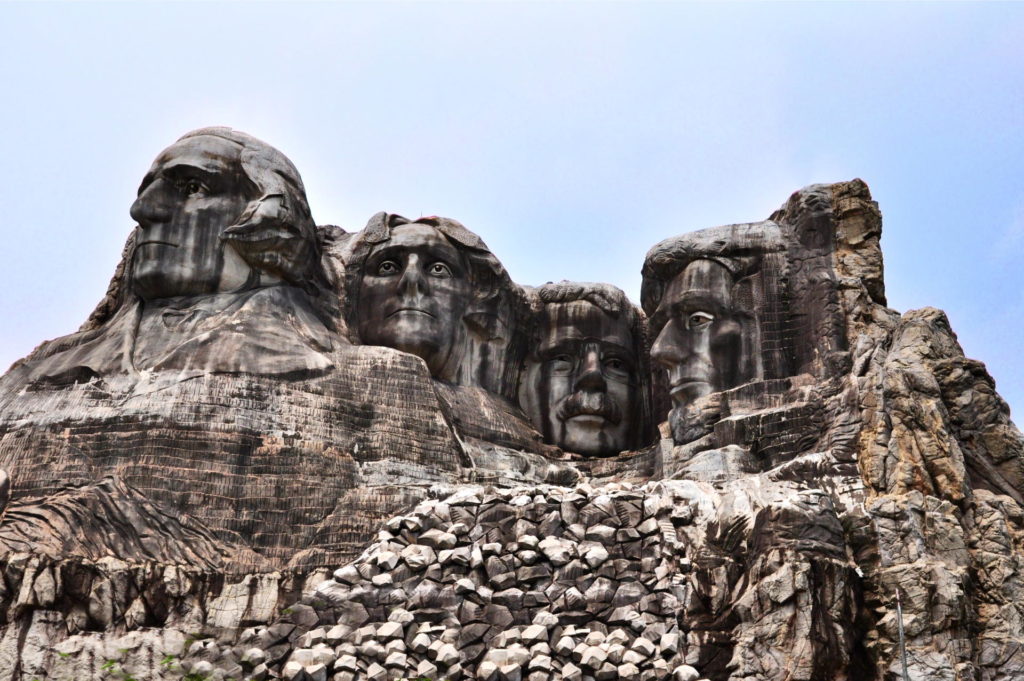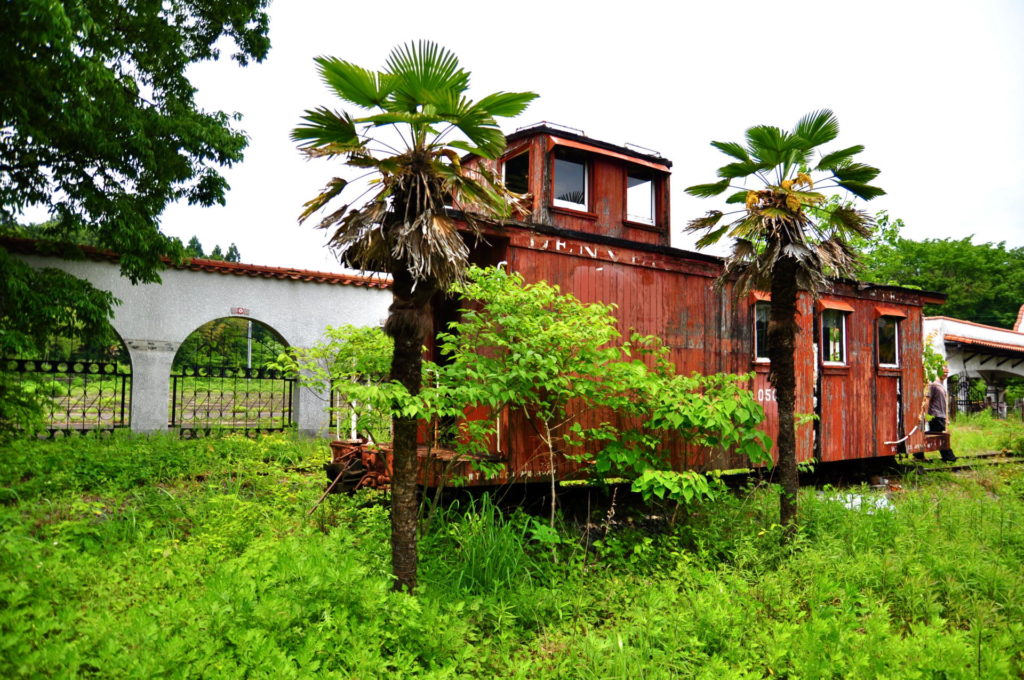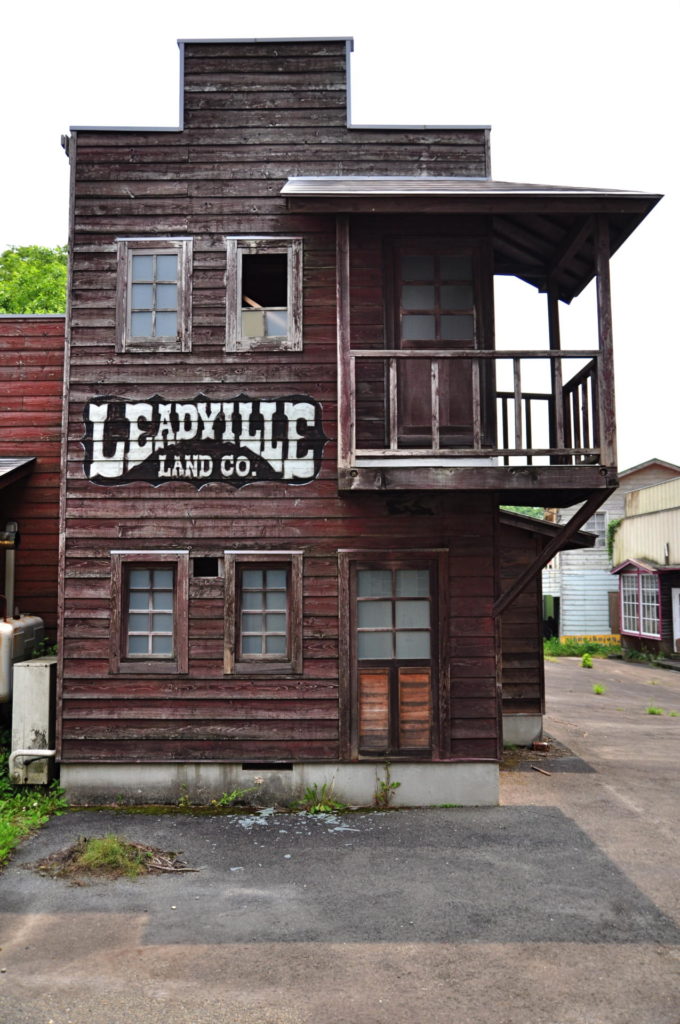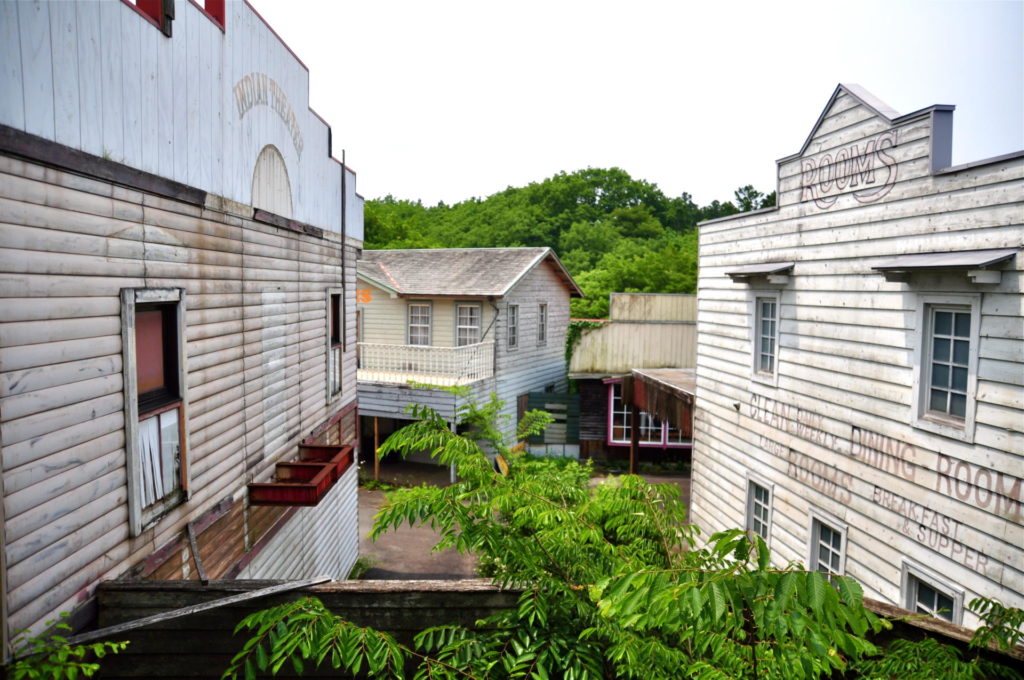John Wayne is in Japan. He stands at the stagecoach station of his little cowboy town in the Tochigi countryside, a moldy American flag draped across his threadbare head, waiting to reprise his breakthrough role as a stagecoach attendant. Inside his chest nestle vacuum tubes and wires, the means by which he once spoke and moved, delighting the masses that came his way.
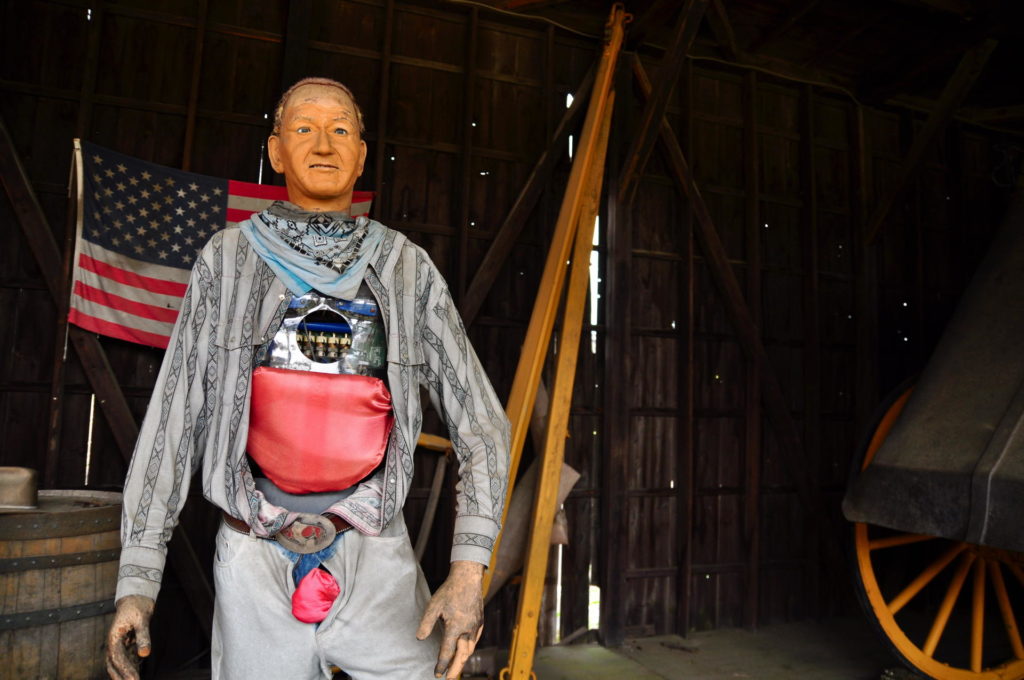
He is an animatronic mannequin, abandoned along with the giant theme park around him known as Western Village. Some joker has since unbuttoned The Duke’s fly, and stashed a plush red pillow down his pants. Such indignity, but he bears it as stoically as ever.
Western Village is now a haikyo; a ruin left untouched and largely preserved since the day it shut its doors in 2007. A few weeds have grown through the main drag in front of the saloon, a few doors have been smashed in, but it remains much as it was, much as its one eccentric founder dreamt it to be.
I went there to explore and take photos. The stockade wall was tall and sturdy, the gate unbroken, but the door to the ghost house was unlocked, so in I went. Inside it was pitch black, and my flashlight made little dent in the gloom. I was startled when the dull beam settled on various creepified Western stalwarts such as skeletal pistoleers, the demise of a frontier dentist, zombified tomahawk-wielding Indians and, of course, more cowboys with their pants down.
Out, and I entered the park proper. There, John Wayne stood between two full-size stagecoaches, an animatronic hostler who once greeted visitors to the park. Now, with his vacuum tube innards on display, he looked more like the killer cowboy robot from the Michael Crichton movie, “West World.”
I wandered down past the saloon, through its swinging doors, and found prop guns, whiskey and saddles still lying around. Across the dirt street was a fun-house with slanted floors and walls, then a West-themed game center, replete with a massive stuffed cowboy toy, presumably the park’s mascot. I tried to pose him for a photo, but his head was too heavy and kept tilting over.
ORIGINS
Western Village was the brainchild of a Japanese businessman named Kenichi Ominami, who took a trip to the U.S. in 1970 and came away enchanted. Back in Japan he started a four-acre ranch where tourists could come for such cowboy-esque pursuits as horse riding, lasso practice and fishing. As time went by, he expanded it with wooden facades, horses and dusty thoroughfares, until it resembled a John Ford Western set.
In time, he hired foreign wranglers and cowboys to populate it, and they put on shows similar to the parades at Disneyland, involving stunts, shootouts and displays of gunmanship skill, with apples shot off unwitting guests’ heads William Tell-style. Through the 1980s, the park expanded further, as guest numbers rose to near one million per year.
It was in 1995, around the apex of that popularity, when the Mt. Rushmore project began. It was to be the symbolic pièce de résistance of the park and pull everything together the way the Sleeping Beauty castle unifies Disneyland. At a whopping cost of $27 million, Ominami had the original Mt. Rushmore replicated at an exactingly accurate 1/3 scale, on top of a building at the edge of his park, overlooking the Shinkansen tracks.
On my trespassing trip, I walked around it, hungry to take in the giant faces on top of a building. It was remarkable; it’s huge, but as grand central structures that pull their landscapes together go, it’s an odd one. First, you can’t even see it from within the park. Second, it doesn’t fit all that well with the park’s cowboy theme. Did cowboys wage shoot-outs on Roosevelt’s face, or rustle cattle out of Lincoln’s big nose?
Of course not.
Still, it was impressive. I don’t know how they thought they’d get the money back on their investment; they probably expected a long life ahead of it. They couldn’t know it would shut down in 2007, shortly after Ominami died.
A window in the building’s ground floor was broken, so I climbed inside. On the ground floor, there were teddy bears everywhere. Above that were huge, mostly empty floors where all manner of games would have lain in wait.
Toward the top, there was a presidential museum, a trail of tears life-size diorama, and a replica of the Lincoln Memorial, alone in the dark. By flashlight, I could see his jaw was hinged; probably he once recounted, in stirring bass Japanese, the Gettysburg Address.
Further up, I peered into the steamy hot president’s heads themselves. The inside of Washington’s brain seemed to be a red inferno, as the sun baked his skin, and it stank of chemical plastic and plaster.
The original sculpture in South Dakota is carved in granite and will never tarnish or collapse on itself. The Western Village Rushmore will probably be demolished some time soon, as its fiberglass-reinforced plastic faces collapse inward.
Beyond that, there was Mexicoland. I had to cross the Rio Grande first, with a brook running down its concrete-track that split Ominami’s property in two. On the other side was a full-gauge train track, spotted around with plastic figures like a giant train-set: the signalman, Indians in the bushes and a windmill.
In a shed at the far end of the park, I stumbled upon two full-size, genuine steam train locomotives. It seems Ominami had more money than he knew what to do with. The park became his personal playground, kind of like Michael Jackson’s Neverland Ranch.
So why did Western Village fail? It had spectacle, grandeur and heart. But competing parks in Japan such as Disneyland and Universal Studios slowly put the squeeze on it. Fewer and fewer people came. It gradually died. But was it a failure? In the words of Kenichi Ominami himself (from the Outwest newspaper, 1997):
“I’m an example of a self-made man. The goal of life is not to make money, but to make your dreams come true.”
From that perspective, he was a grand success. Western Village is his dream made real, and it still has a haunting beauty, perhaps infused with his spirit still—unlike other abandoned parks such as Nara’s infamous Dreamland (a Disneyland clone that rode high until the real Disney came) which feel sterile to wander now that they’re abandoned.
Leaving Western Village behind, I felt the familiar blur of nostalgia and satisfaction. I’d seen all it had to offer, but a little bit of me remained curious, wondering what it might have been like in operation; mannequins talking, shootouts going down and buffalo steaks roasting on the pit-fires.
I wonder what John Wayne would have thought about it, if he’d seen the great Rushmore heads and the steam trains and all the wild extravagance of the place. Perhaps, in The Duke’s own drawl, he’d say, “It’s getting to be ri-goddamn-diculous,” though perhaps he’d say it with a smile in his eyes.





